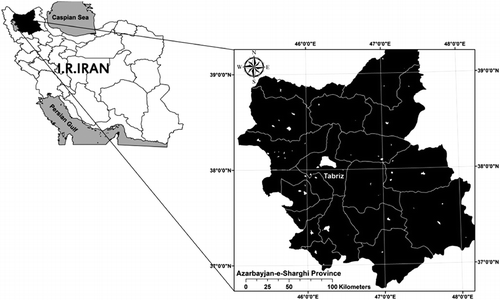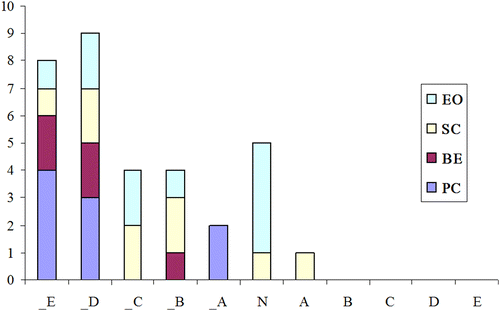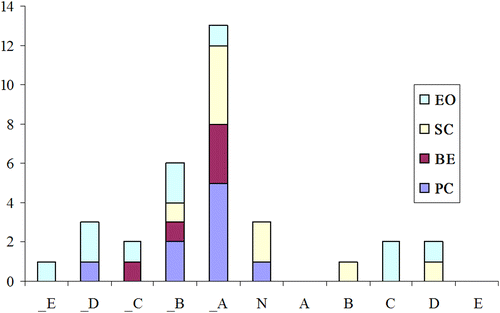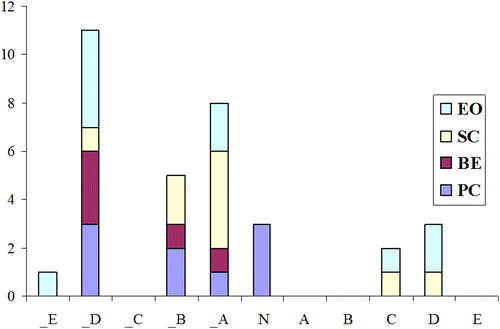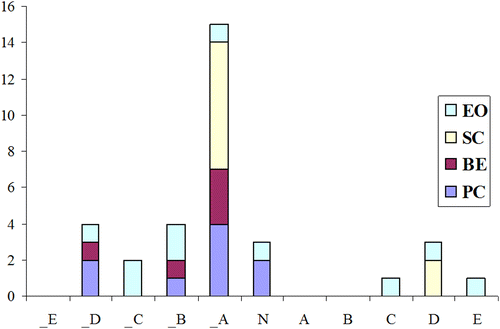Abstract
The irregular and non-normative development of cities and also weakness in the waste management system has created many problems especially in large cities. However, even many of the principles of engineering and environmental criteria about burying of wastes do not match in the landfill sites. Therefore, environmental impact assessment (EIA) for landfills to examine the effects of landfills on environment is essential. Rapid impact assessment matrix (RIAM) is one of the ways that it can be used to EIA. This method minimizes the elements of subjectivity and introduces some degree of transparency and objectivity. Using the RIAM, EIA has been carried out on different municipal solid waste disposal options in Tabriz landfill and it has been found that composting with the sanitary landfill is the best recommended option according to the existing circumstances.
Introduction
Environmental impact assessment (EIA) is an effective method which evaluates the effects of different sectors and activities of a project on environmental components and finally according to results of this assessment offers solutions to reduce negative effects (Canter Citation1996, p. 2). Enforcement of inappropriate policies and indiscriminate exploitation of natural resources in Iran in the past few decades led to Iranian environment being subject to changes and serious injuries. Hence, since 1975 to ensure the protection of environment and compliance with sustainable development goals, some of the major constructional projects according to government approvals and legislative assembly were bound to prepare an EIA report. Municipal waste landfill plans were one of these projects which with the completion of national laws were bound to prepare this report (Monavari Citation2002, pp. 9–16).
Municipal solid waste (MSW) generation is an issue of worldwide concern (Sehker & Beukering Citation1998, p. 278). Urbanization and improving living standard in cities of developing countries have led to increase in the quantity and complex composition of MSW (Glawe et al. Citation2005, p. 2).
MSW disposal site is one of the projects that, if the EIA is not done on it, causes severe negative effects on the environment. Problems of unsanitary disposal sites and environmental risks by these landfills, specifically hospital and industrial wastes, caused substitution of environmentally sound and sustainable methods instead of traditional methods (Monavari & Arbab Citation2005, p. 4). The main objective of EIA projects in MSW landfills is to understand the current situation of landfill and, given the current situation, appropriate enforcement strategies should be presented to improve the quality of the environment and reduce pollution caused by landfilling.
Rapid impact assessment matrix (RIAM) is one of the tools for assessment of landfills (Mondal et al. Citation2010, pp. 541–546). Because this method is able to integrate all of the components and various parameters, it is an ideal mechanism that guarantees clear and rapid assessment of the environmental impacts of a project (Pastakia Citation1998, p. 12). Also RIAM has advantages which encourage this method to be used in this study. In particular, it minimizes the elements of subjectivity and introduces some degree of transparency and objectivity. In this method along with carrying out EIA for the project, the process of operation is documented simultaneously which causes saving the amount of required time (Pastakia & Jensen Citation1998, p. 462). Also from a practical point of view, RIAM makes it easy for the user to assess procedures; because an expert will have a matrix in which each of its cells has very useful information that offers magnitude and significance of effects, and finally, the user is able to reach a conclusion. In fact, the RIAM method makes it possible to carry out a global analysis of the results based on individual environmental score (ES) for each component, which is classified in ranges and so can be compared with each other (Baba Citation2007, p. 471).
Tabriz the largest industrial city in north-west of Iran with an approximate population of 1/600,000 is faced with production of more than 1/200 tons of waste per day, i.e. an average waste generation of almost 710 g per capita per day. Due to high moisture content of the generated waste, a significant amount of leachate is generated in the Tabriz landfill site which drains through the natural barrier underneath the dumpsite into existing dents or constructed ponds where it is stored with no further treatment. Lack of compression on waste and lack of daily cover soil causes emission of odors and greenhouse gases to atmosphere. Also, spontaneous combustion of wastes occurs in this landfill. The aim of this research is to carry out a good EIA according to existing data and to present conditions in the Tabriz landfill and it is considered that based on results of RIAM, the most practical strategy for landfill is suggested (Figure ).
Materials and methods
RIAM stages
The assessing process by RIAM focuses on four categories of environmental components, which are defined as follows (Mondal et al. Citation2010, p. 452):
Physical/chemical (PC)
Biological/ecological (BE)
Sociological/cultural (SC)
Economic/operational (EO)
There are two important criteria for assessing by RIAM (Pastakia Citation1998, p. 12):
(A) Criteria that are of importance to condition, and which can individually change the score obtained. | |||||
(B) Criteria that are of value to the situation, but individually should not be capable of changing the score obtained. | |||||
The values assigned to each of these criteria are determined by a few simple formulae as follows: scores given to each of the criteria in group (A) are multiplied with each other and the scores given to each of criteria in group (B) are added together and finally sum of the group (B) scores are multiplied by result of group (A) scores to provide a final assessment score (ES) for the condition. The process for RIAM in its present form can be expressed as:
Table 1 Assessment criteria.
For beginning the evaluation process, a matrix is formed for each option under review, where the columns represent used criteria and rows represent environmental components that have been chosen, and within each cell of matrix the individual criterion scores are set down. Using formulae presented in Equations 12(3), ES is calculated and recorded. In the final stage, ESs derived from the assessment should be classified in a range to be done by comparing the results. Ranges are defined by conditions that act as markers for change in bands. Finally, ES results in different range bands according to component type presented in the tables and graphs. Table gives the ESs and range band currently used in RIAM (Kuitunen et al. Citation2008, p. 314).
Table 2 Conversion of ESs to range bands.
Options and components
In this research, RIAM analysis has been carried out on four options as follows:
Open dumping
Sanitary landfill
Recycling
Composting
The current activity that is taking place in Tabriz MSW disposal site, as previously mentioned, is open dumping. In this option, wastes are released to the environment without any masking operation and thus will be the cause of diseases and pests and will lead to serious environmental damages. So the solution must be sought to best deal with Tabriz MSWs.
Sanitary landfill, in fact, is a controlled method of solid waste disposal, in which wastes on the basis of a forecast plan are disposed forever from the living environment and reserved in the soil (Omrani Citation1997, p. 177). This is due to the fact that wastes are dumped in a particular place which is uninhabited, so that it does not cause any threat to public health and safety. In the sanitary landfill method, there are no environmental problems such as unpleasant odor and contamination of soil, air, surface and groundwater, because in this method, wastes are buried in the soil, and by layering and covering wastes, no harm is caused to the environment, humans and other organisms.
Recycling is a process in which waste materials are collected and after separating are used as raw materials to make new products (Omrani Citation1997, pp. 18–34). By using materials more than once, natural resources will be preserved (Salvato et al. Citation2003, p. 761). Based on existing literature, recycling process of wastes after waste reduction programs has been on top of the solid waste management program (Tchobanoglous et al. Citation1993, p. 110).
Composting is a solid waste management strategy by which disposed mixed municipal wastes are reduced in size and weight, thus reducing odor and leachate emissions and resources recovery and reducing costs of disposal. So because of the presence of high percentage of perishable and organic materials in MSWs, the compost product can be used as fertilizer by farmers and especially in plants for landscaping (Soumare et al. Citation2003, p. 519).
Ten PC components, 7 BE components, 10 SC components and 11 EO components have been considered. These components were selected based on literature review and the main components were found in an area that we chose between different components and finally we arrived at these presented components.
Then the prepared questionnaire was based on the mentioned components and was distributed among local people, who are residing nearby the landfill, and municipality functionaries as well as experts. The questionnaire of this study was designed after finalizing components in each part of the environment. In order to simplify the language of the questionnaire so that the local people could avoid ambiguity and confusion while responding to the questions, we have tried to design the assessment criteria, as given in Table , as qualitatively and close to the spoken language. Of course the questionnaire for experts and professionals was designed separately. During distribution of questionnaires, we have tried to cover 25–30% of the statistical community (local people living near landfill). Comments of five municipality functionaries and eight environmental experts on the questionnaire were also used. As an example, average results for option 1 based on the completed questionnaire are shown in Table .
Table 3 RIAM analysis (option 1: open dumping).
Results and discussion
Summary scores of RIAM analysis are shown in Table . Furthermore, results of the RIAM analysis for each of the proposed options with their figures are given.
Table 4 Summary scores of RIAM analysis.
Option 1: open dumping
Results of analysis for option 1 show that, except for very small and negligible positive effects on SC components, as shown in Figure , it has very negative effects on the environment because wastes without being separated and pre-processed are discharged to the environment and leachate from wastes effects directly on surface waters and underground aquifers. On the other hand, unpleasant odors released into the environment and resident microbes in wastes have impacts on public health. Also open dumping is not economically affordable. This method is only partially preferred for wastes that are not biodegradable and recyclable.
Option 2: sanitary landfill
Regarding option 2 as shown in Figure , investment and administrative, operational and maintenance costs are higher than those for option 1. In contrast, the overall positive effects of sanitary landfill are higher than those of option 1. These positive effects are because of reduction in emission of gases and other toxic compounds to the environment, reduction of unpleasant odors, reduction of incidence of disease by birds and insects and reduction of explosions and fires at the disposal site. Treated water from the leachate can be used to create green space at disposal site. The produced gas can also be sold as fuel to offset the cost of landfill.
Option 3: recycling
Recycling helps to prevent loss of natural resources and reduces energy and raw materials consumption and, thus, recycling reduces greenhouse gases emission to the atmosphere. Although recycling is itself an energy consuming process and can cause extra greenhouse gases emission, emission of atmospheric pollutants from recycling materials would be much lower than emission of the same pollutants from raw materials (Bohm et al. Citation2010, pp. 864–871; Tonjes & Mallikarjun Citation2013, p. 2548). For example, recycling of paper causes 75% reduction of air pollution, 50% energy saving and 90% reduction of water pollution compared with production of paper from wood and raw materials (Craighill & Powell Citation1996, pp. 75–96; Omrani Citation1997, p. 115). Apart from wastes that have potential to produce compost, many of the components present in wastes (such as paper and paperboard, glass, cans, woods, plastics, metals, rubber and so on) are recyclable. The recycling option such as composting as shown in Figure has significant positive impacts on the environment, but this option also has negative effects due to costs.
It should be noted that the negative effects are not only for EO components, so that is clear the construction and operation of any recycling plant caused damages to PC and BE environmental components and also possible that the public acceptance SC reduced due to pollutions produced by factory. Of course it should not be forgotten to mention that contribution of construction of a new factory to the local economy could also increase the social acceptance of this alternative which as shown in Figure shows that the best possible way for the positive and negative aspects of social acceptance of manufacturing is the recycling factory.
Option 4: composting
Composting is one of the management strategies of MSW, which can be used for purposes such as reduction of weight and volume of materials that must be disposed, reduction of odor and leachate emissions and reduction of disposal costs. Due to the high percentage of putrescible materials in MSW, the product obtained from composting can be used as fertilizer by local farmers. Producing fertilizer from wastes and recycling of putrescible materials has a notably economic value, which is achieved through the sale of compost, and this income can offset huge cost of waste collection and disposal. Figure shows results of composting option. In case of failure to comply with environmental and health aspects, consequences of these cases will threat public health and the environment. Also, cost of building a compost plant causes increase in negative effects of the EO components.
Conclusion
The EIA for Tabriz landfill was carried out to evaluate impacts of the four different options (three alternative options). These options, respectively, were open dumping, sanitary landfill, recycling and composting. For this purpose, RIAM that is a very effective and rapid method to demonstrate impacts of these options was used. According to the results of this study, it is clear that the open dumping option, of all the investigated options, has very negative effects, because in this method as previously mentioned, wastes without any processing and separation are discharged into the environment. Undoubtedly, leachate from wastes will contaminate both surface waters and ground waters. Odors and microbial agents present in wastes will also impact on public health. Also economically, there is no profit and income from this method.
The other three proposed options are more preferred than the first option and their positive effects can be considered and evaluated. But to choose the best option of these three proposed options, the total results which obtained in each class for each option (Table ), multiplied by contractual scores which given in Table and values summed together and finally the resulting number considered as the total value for each particular option.
Table 5 Contractual scores.
Positive and negative values for sanitary landfill, recycling and composting, respectively, are ( − 48/+16), ( − 67/+18) and ( − 45/+20).
Thus, according to the results, open dumping replacement priorities are, respectively, composting, sanitary landfill and recycling options. Results of EIA studies with RIAM done by Mondal et al. (Citation2011) and El-Naqa (Citation2005), respectively, in Varanasi landfill in India and Russeifa landfill in Jordan, showed that the sanitary landfill option is the best option to replace the current activity in the disposal site (open dumping). In this research, due to the high population of Tabriz which generates large volume of waste in this city (1200 tons per day), of which 70% is biodegradable and putrescible materials and considering that almost 24% of the city's surroundings constitute of agricultural and horticultural activities, the composting option primarily with sanitary landfill option can be considered as the best alternative option to Tabriz landfill. Positive effects of the composting option can be interpreted so that the high percentage of MSWs is biodegradable and putrescible materials and thus raw materials for composting option is far more than the recycling option. Therefore, in addition to environmental compatibility of composting options, revenues from sale of compost as the fertilizer also will be high, this causes increase of positive effects of this option. But negative effects of the composting option may be due to high costs of building a typical compost plant. Also along with production of compost, sanitary landfill of residual wastes in addition to preventing of environmental pollutions and degradation of surface water and groundwater quality due to leachate releasing will lead to energy production and thus can be profitable. However, the building and construction costs would be too high and this must be considered.
In conclusion, the RIAM as a tool for assessing and calculating could reflect opinions of people and experts comprehensively and this is not with words or speech, rather it was realized by graphs and documented results. Therefore, anybody cannot hide the fact that the situation of Tabriz's landfill is regrettable. It is important to note that the tools such as RIAM in developing countries which do not have sufficient and appropriate infrastructure to conduct costly assessments for projects are very useful and effective. Therefore, in this study it is clear that RIAM could perfectly review strengths and weaknesses of each of the three proposed alternatives in terms experiment and theory. This means that all components of the environment were analyzed in terms of positive and negative effects of each option. So, this research is an analysis and presentation tool for Environmental Impact Assessment (EIA) and Initial Environmental Evaluation (IEE), which allows the decisions of managers and urban planners of Tabriz who are responsible for policy-making in this field to be completely transparent and easily understood.
References
- BabaA. 2007. Application of rapid impact assessment matrix (RIAM) method for waste disposal site. In: Managing critical infrastructure risks. The Netherlands: Springer; p. 471–481.
- BohmRA, FolzDH, KinnamanTC, PodolskyMJ. 2010. The costs of municipal wastes and recycling programs. Resour Conserv Recycl.54:864–871.
- CanterLW. 1996. Environmental impact assessment. New York: McGraw-Hill.
- CraighillAL, PowellJC. 1996. Lifecycle assessment and economic evaluation of recycling: a case study. Resour Conserv Recycl.17:75–96.
- El-NaqaA. 2005. Environmental impact assessment using rapid impact assessment matrix (RIAM) for Russeifa landfill, Jordan. Environ Geol.47:632–639.
- Glawe U, Visvanathan C, Alamgir M. 2005. Solid waste management in least developed Asian countries – a comparative analysis. International Conference on Integrated Solid Waste Management in Southeast Asian Cities; July 5–7; Siem Reap, Cambodia.
- KuitunenM, JalavaK, HirvonenK. 2008. Testing the usability of the rapid impact assessment matrix (RIAM) method for comparison of EIA and SEA results. Environ Impact Assess Rev.28:312–320.
- MonavariM. 2002. Environmental impact assessment pattern of municipal solid waste disposal site. Organization of Tehran Municipality's Recycling and Conversion materials, Department of Education and Research. Tehran: Sineh Sorkh Publication.
- MonavariM, ArbabP. 2005. The environmental evaluation of municipal solid waste landfills of the Tehran province. Environ Sci.2(8):1–8.
- MondalMK, Rashmi, DasguptaBV. 2010. EIA of municipal solid waste disposal site in Varanasi using RIAM analysis. Resour Conserv Recycl.54:541–546.
- OmraniGH. 1997. Solid waste – management, Collecting, sanitary landfill and compost production. 2nd.Tehran: Scientific Publication Center of Islamic Azad University.
- PastakiaCMR. 1998. The rapid Impact assessment matrix (RIAM) – a new tool for environmental impact assessment. In: JensenK, editor. Environmental impact using the rapid impact assessment matrix (RIAM). Fredensborg: Olsen & Olsen.
- PastakiaCMR, JensenA. 1998. The rapid impact assessment matrix (RIAM) for EIA. Environ Impact Assess Rev.18:461–482.
- TchobanoglousG, HilaryT, VigilSA. 1993. Integrated solid waste management: engineering principles and management issues. New York: McGraw-Hill.
- TonjesDJ, MallikarjunS. 2013. Cost effectiveness of recycling: a systems model. Waste Manage.33:2548–2556.
- SalvatoJA, NemerowNL, AgardyFJ. 2003. Environmental engineering. New York: John Wiley & Sons.
- SehkerM, BeukeringPV. 1998. Integrated solid waste management: a perspective on Bangalore (India). CREED working paper series No. 24 . p. 277–295.
- SoumareM, TackF, VerlooM. 2003. Characterizations of Malian and Belgian solid waste composts with respect to fertility and suitability for land application. Waste Manage.23:517–522.

